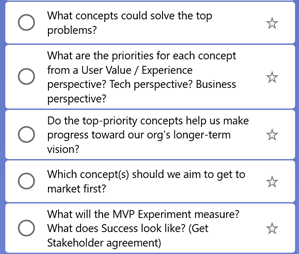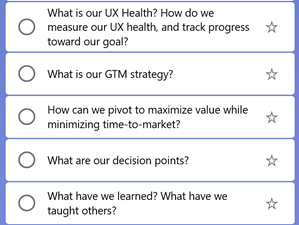By Valentina Strachan (opens in new tab)

Photo credit: iStock
The excitement of innovation research and blue-sky thinking is often clouded by worries that incubation is risky. Of course, most incubations will fail, like most startups. However, every project can lead to invaluable insights for both the project team and the larger company.
In this article, I share a structured approach to “learning while incubating,” derived from my experience leading incubation research. Use the accompanying Incubation Checklist from this article to turn your incubation project into a “learning success story.”
The Four Phases of Incubation. Each phase of our incubation process has a distinct set of learning goals:
1. Define your long-term vision,
2. Decide what should be shipped as the Minimum Viable Product (MVP),
3. Design a v1 of your product with a great user experience, and
4. Go To Market with the solution.
At every step along the way, make sure you are hypothesis-driven, so that you can plan to collect the right kind of data, and to pivot in a data-driven way.

Phase 1 Questions
Phase 1: Define your Long-Term Vision
By the end of this phase, you will have a comprehensive understanding of the problem space, and a clear long-term vision for your product.
UX Researchers can help the team generate informed hypotheses for the Incubation Checklist questions to the right, by conducting literature reviews, internal team activities, and agile studies with external customers.
It will be key to have the technology experts, the business experts, and the UX experts all interacting with users directly, to hear first-hand about their current behaviors, solutions, and pain points. This phase is all about diverging: generating as many hypotheses as possible, to define a comprehensive futuristic vision together.

Phase 2 Questions
Phase 2: Decide what to ship as MVP
Once you’ve gone broad, phase two is a period of prioritization to bring clarity and concreteness to the long-term concepts, and to define the MVP (minimum viable product). It answers: What’s the priority of the uncovered value props from Phase 1: for our customers, for the business, and given our technology?
UX Writers and UX Designers bring clarity to the value props for the customer problems you uncovered in Phase 1, through wording and high-level concept designs. Foundational UX Research in this phase can include: Concept value tests, Customer segmentation studies, Data Science explorations, and/or BXT internal activities.

Phase 3 Questions
Phase 3: Design v1 of the MVP
Phase three marks a period of foundational research focused specifically on the concept you decided to go after. For example, you might want a competitive benchmark study, to understand who the leaders are in the space you’re embarking onto and what their specific strengths are–as well as what mistakes to avoid. Heuristic Evaluations and Diary Studies are also great at this phase, to understand users’ current solutions and behaviors.
UX Designers play a crucial role in this phase, which results in the first version of the designs for your new product.
*Note: Many teams might try to start their Incubation in Phase 3 – with the goal of having a v1 of the design. This is OK, but if you enter here, try to answer the Checklist questions for phases 1&2 here too, before moving to Phase 4.

Phase 4 Questions
Phase 4: Go to Market
Congratulations! With phase four, you’re on the home stretch, but don’t lose steam: Make sure to follow through. The goal is to get first-to-market with a great experience and to process the feedback and pivot, at every step – together.
Data Science plays a crucial role in this phase. Usability studies are conducted on early versions of the designs by UX Researchers (e.g., agile usability studies, UX scorecard studies). But you’ll need to quickly progress to analyzing user feedback at scale (e.g., dogfood feedback, behavioral telemetry, in app survey data, app store feedback, feature requests, A/B experiments), as more and more users adopt your product.
The process is cyclical in nature. Once v1 of your product is in-market, you’ll be thinking about v2. But it’s much easier to go through the Incubation phases the second time around: your long-term vision is already defined (phase 1), you have direct user feedback from your MVP to decide on your next concept (phase 2), etc. Really, any new release of a product can be treated as an Incubation Project.
Ultimately, a lot of incubation projects fail. However, by answering the questions in the Incubation Checklist, you will not only have increased your project’s chance at success, but you’ll also have structured your insights in a way that can transfer what you’ve learned to your team’s (or your company’s) next incubation.
What do you think? How can you put these questions and this process to use in helping your next incubation project be successful? Tweet us your thoughts at @MicrosoftRI or follow us on Facebook (opens in new tab) and join the conversation.
Valentina (Grigoreanu) Strachan is a Senior Design Research Lead. She has a PhD in Computer Science with a focus on Human-Computer Interaction (HCI). In her 10 years as an HCI and UX Researcher, she has conducted in-depth research on a variety of software products for end-user programmers, IT professionals, information workers, software developers, and consumers. Valentina looks for ways to push the UX Research discipline forward, such as using Artificial Intelligence to inform HCI/UX Research in all phases, and by creating new research methodologies to speed up the impact of research findings on products. Valentina has more than 20 publications based on this research, which she has presented at leading HCI conferences such as ACM’s CHI, and IEEE’s VL/HCC, and IFIP’s INTERACT.

